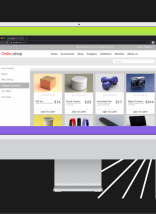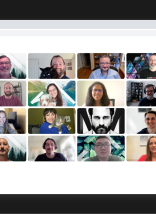As one of the 2,500+ eCommerce experts who attended last week’s Magento Imagine conference in Las Vegas, I looked forward to seeing Magento’s grand vision for the global eCommerce ecosystem. I met a lot of vendors, kicked back with other system integrators, and learned a ton of new technologies and best practices. Here are my main takeaways.
Everybody is Moving to Magento 2. Eventually.
Magento 2 is here. As you might imagine, the new release was a focus of many presentations at the conference, including a success story panel I attended. This panel discussed three projects that had been done using Magento 2 and described why Magento 2 was the right move for them. Without getting into all the details, I was convinced—if you were developing a new ecommerce site today, you would definitely consider Magento 2 as a solution.
However, two of the three success stories have not launched their website yet. The main reason for these delays were dependencies on third-party vendors to deliver Magento 2-compatible plugins that were not complete yet. As much as it’s easy to complain about third-party plugins, there are a lot of them out there that are essential to keeping the budget on a project reasonable. Even so, the lesson here is clear: If you are starting a Magento 2 project today, make sure any plugin you need is already available or has a definitive timeline for availability.
It’s also worth noting that all three companies were in desperate need of a new ecommerce site, but not necessarily a Magento 2 site. In every instance, the requirements and needs for a new ecommerce site could have been achieved by Magento 1. Magento 2 does offer more features, a modern admin interface, modern programming standards, and a much easier testing infrastructure. That said, if you are on Magento 1 and you have a well-functioning website, then there’s no current need to transition to Magento 2 in the near future.
When I discussed this point with several developers at the conference, most said they had taken the training for Magento 2 and had either just started a Magento 2 site or hadn’t actually built one yet. This leads to the natural question: “When should I move to Magento 2?” The short answer is “whenever you need to rebuild your site.” Basically, you should only make the transition to Magento 2 if it makes business sense. And unless you are on a near-stock version of Magento, a migration from 1 to 2 should be treated like a site rebuild.
The Battle for B2B E-commerce
The battlelines have been drawn: you’ve got Magento on one side, and on the other you’ve got Oro, a company which consists of all the original creators of Magento. Oro even had their own Oro Momentum conference the day before Imagine at the same hotel.
This conference showed off the new beta for Oro commerce and the other products built on the Oro Platform. Oro Commerce is the real interesting piece of software, being a customized B2B catalog and shopping cart. This platform includes everything you could ever want from a B2B shopping experience, including tailored catalogs, custom price lists, SKU lookups, order grid, etc. Oro has repeatedly said they are creating an easy way for system integrators to integrate ERPs into this system. Everything about this feels like the way that B2B e-commerce should be done and it feels like it was built that way from the ground up.
Magento on the other hand, is also launching a B2B feature set over the summer. They didn’t give a lot of specifics on it but it did sound like custom catalogs and price lists were at least included. Magento currently is the most popular B2B ecommerce platform right now but it is mainly because there is not a ton of competition in the space. Oro is bringing a very real alternative to the table and Magento is looking to match this.
Magento Reenters the PaaS Space with Magento Enterprise Cloud
Magento is entering the Cloud Service space again. But this time, Magento Enterprise Cloud aims to be everything Magento Go should have been. While Magento Go offered a turnkey solution that was easy to implement, a typical merchant looking to use Magento requires a solution that allows deep customization. This was why Magento Go failed, and why Magento Enterprise Cloud has a good chance to succeed. Merchants can easily integrate this new Platform as a Service(PaaS) into all of their third party systems and match it to their business use cases. Magento Enterprise Cloud also provides a best practice infrastructure setup to simplify things further.
After watching a technical presentation on this, I asked some of their engineers which kinds of companies this solution would best fit. For Atlantic BT, it probably would not make much sense because our hosting and infrastructure setup is nearly identical to what they’re providing. Instead, Magento Enterprise Cloud works best for development groups who do not do their own hosting and infrastructure and do not want to. The admin dashboard for Magento Enterprise Cloud makes it very easy for a developer to deploy code to dev, QA, or prod without ever needing to know anything about the hosting and infrastructure.
Pricing for Magento Enterprise Cloud will be announced in a few weeks. When that happens, we’ll really know how competitive of a hosting option this is.
Magento Marketplace 2.0
There are a lot of problems with the old Magento marketplace, the biggest of which is the average quality of code. Right now, when somebody says they want to install something out of the marketplace, my first assumption is “that plugin is probably garbage and will not work.” This sounds harsh, but as an experienced Magento developer that’s what we’ve grown accustomed to with the plugins available.
Marketplace 2.0 aims to change that. The new Magento Marketplace adds real code audits and reviews to verify the plugins follow best coding practices and standards. While this will make it more difficult and time-consuming for developers to get plug-ins into the marketplace, these new standards should assure that only quality plugins are available. As a developer, I really hope this is successful so all of us in the community can have faith in the plugins coming from the marketplace again.
The Conference as a Whole
Going into the conference, I was skeptical about the direction Magento was going. This was the first conference that Magento has hosted since their split from Ebay. However, it seems obvious from the conference they are building momentum on bettering their internal products and offerings as well as a plethora of support from the community. Magento 2 may be slow for adoption, but it looks to be a viable option now and a major player in the years to come.
If you have thoughts on the Magento Imagine conference, I’d love to hear them. Feel free to comment in the discussion section below.








